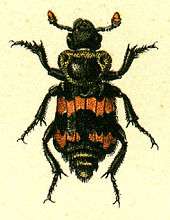Nicrophorus vestigator
| Nicrophorus vestigator | |
|---|---|
| | |
| Nicrophorus vestigator. Museum specimen | |
| Scientific classification | |
| Kingdom: | Animalia |
| Phylum: | Arthropoda |
| Class: | Insecta |
| Order: | Coleoptera |
| Family: | Silphidae |
| Subfamily: | Nicrophorinae |
| Tribe: | Nicrophorini |
| Genus: | Nicrophorus |
| Species: | N. vestigator |
| Binomial name | |
| Nicrophorus vestigator Herschel, 1807 | |
| Synonyms | |
* Indicates the name was assigned to this species on multiple occasions without the knowledge the name had already been used to describe the same species. | |
Nicrophorus vestigator is a species of beetles belonging to the family Silphidae.
Varietas
- Nicrophorus vestigator var. bipuctatus Portevin, 1914
- Nicrophorus vestigator var. brullei Jacobson, 1910
- Nicrophorus vestigator var. caretti Pic, 1933
- Nicrophorus vestigator var. degener Carret, 1901
- Nicrophorus vestigator var. obscuripennis Portevin, 1914
- Nicrophorus vestigator var. rautenbergi Reitter, 1900
- Nicrophorus vestigator var. viturati Pic, 1917
Description

Nicrophorus vestigator can reach a length of about 14–22 millimetres (0.55–0.87 in). The basic color of the body is black, with two wide transversal orange stripes on the elytra. These beetles have large club-like antennae equipped with black and yellow tips. The legs are strong. The last three abdominal segments protrude beyond the elytra.[2]
Like other burying beetles they bury the carcasses of small vertebrates such as birds and mice as a food source for their larvae. Larval development takes place during the summer, and the fully formed individuals can be found mainly in May-June and in August.[2]
Distribution
This species is present in most of Europe, in the East Palearctic ecozone and in the Near East.[3]
Bibliography
- Sikes, Derek S., Ronald B. Madge, and Alfred F. Newton (2002) A catalog of the Nicrophorinae (Coleoptera: Silphidae) of the world, Zootaxa, no. 65
- Baranowski, R. 1982. Intressanta skalbaggsfynd 6. Ent. Tidskr.103: 130–136.
- Hansen, V. 1968. Biller XXV. Adselbiller, stumpbiller m.fl. Danmarks Fauna 77.